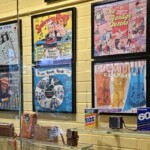 Steely Dan: The band that was too cool for touring, too cool for the Grammys, too cool for the Rolling Stones, and too cool for Top 40 hits. They placed Duke, Miles, Debussy, and Coltrane on pedestals, which isolated them from the hippies at their alma mater, Bard College in upstate New York. They fused jazz and pop in unprecedented ways, and placed quality well over commercialism, garnering them the title “rock’s most obsessive nit-picks.” They cared only about the music and could give two shits if they were photographed on the red carpet or at some ritzy Hollywood hotel party.
Steely Dan: The band that was too cool for touring, too cool for the Grammys, too cool for the Rolling Stones, and too cool for Top 40 hits. They placed Duke, Miles, Debussy, and Coltrane on pedestals, which isolated them from the hippies at their alma mater, Bard College in upstate New York. They fused jazz and pop in unprecedented ways, and placed quality well over commercialism, garnering them the title “rock’s most obsessive nit-picks.” They cared only about the music and could give two shits if they were photographed on the red carpet or at some ritzy Hollywood hotel party.
Having both grown up on the East coast, Fagen and Becker listened to local jazz radio programs like Symphony Sid. In order to keep the lights on, jazz stations played a lot of Latin jazz from the ’50s and ’60s, and those influences are evident on the Dan’s impressive catalogue. But before Steely Dan came into existence, Fagen and Becker cut their teeth as session players along the eastern seaboard and tried selling songs as staff writers around the Brill Building and later at ABC-Dunhill (the latter thanks to an auspicious friendship with Gary Katz), but their lyrics were far from the upbeat Supremes’ 45s that dominated the airwaves of the late ’60s and early ’70s as evidenced in the Grassroots’ rejection of their song “Tell Me A Lie.” Barbara Streisand, however, ended up recording their song “I Mean to Shine” in 1971. They spent a year and half backing up Jay & the Americans on a couple tours, got a feel for the giant stages of Madison Square Garden, but Fagen and Becker always planned on having their own group. At night, when the ABC-Dunhill building was empty, Fagen and Becker would sneak in and lay the foundation of what would become Steely Dan.
On their first record, Can’t Buy A Thrill, Steely Dan was comprised of what seemed like permanent members, including Jeff “Skunk” Baxter, whose chops can be heard on the brilliant guitar solos of “Only A Fool Would Say That” and “Midnight Cruiser,” but eventually let him run off with the Doobie Brothers. Fagen and Becker preferred to hire session musicians instead of having permanent bandmates for their records, and that in itself is a testament to their longevity. Steely Dan was never a band per-say, rather a concept. In that case, Steely Dan could never be dismembered.
On the one hand with Major Dudes: A Steely Dan Companion, you’ve got archived reviews and interviews on Steely Dan that can be dug up if you have access to your uncle’s crate of 1970s copies of MOJO and Rolling Stone—or the internet. On the other hand, you’ve got a collection of some of the wittiest interviews Fagen and Becker have ever sat down for juxtaposed with a collection of the sharpest commentary from music journalism’s top dogs (Barney Hoskyns, Dylan Jones, Robert Palmer, Sylvie Simmons) that weave together the interesting saga that is Steely Dan. My only reservation? Two female writers among the Steely Dan Companion’s 33 contributors.
Sit poolside and in conference rooms as Fagen and Becker’s esoteric humor attempts to throw off naive journalists, learn about that time Keith Richards banged on their hotel room at 4 a.m. blasting Katy Lied, and impress your friends with your encyclopedic knowledge of Fagen’s recording techniques, like how he discreetly hung a microphone from the ceiling at Studio 54 during one of Steve Rubell’s business parties to achieve the party noises heard on “Ruby Baby” only to toss the recording (that obsessive nit-pick), and then throw his own party where “a lot of people got very drunk, and we got our party noises,” Fagen says.
The first time Steely Dan were invited to the Grammys, they declined because the invitation requested that they “wear beautiful clothes.” “They wanted me to come dressed like Cher!” Fagen says. They never toured because hitting the road would interrupt their energy in the studio. One need look further than Aja—the album that garnered acceptance from the National Recording Registry—to understand how vital continuity is. Performing in venues added another obstacle: The Dan’s sound was too complex for big arenas and they did not want to risk losing an audience to muddled reverberations.
Because of their idiosyncratic sound—with its intricate chord changes, high-register harmonies, and immaculate exteriors, other musicians have found it difficult to cover Steely Dan’s discography. However, plenty of hip-hop and R&B artists have sampled their songs in the last two decades decade. Ice Cube samples “Green Earrings” on his “Don’t Trust ‘Em”; Beyonce blends “Black Cow” on her J’Ty remix of “Me, Myself, and I”; Hit Boy/John Legend tie “The Boston Rag” on “WyW.” Fagen points out that he and Becker usually gave the green light to hip-hop artists who requested to use parts of the Dan’s music; however, when Kanye West requested to sample “Kid Charlemagne” on his 2007 single “Champion,” it was an immediate no. Though the additional income was appealing, “neither of us particularly liked what he had done with it,” Fagen says. Consequently, Kanye wrote Fagen and Becker a handwritten note: “I love your stuff, and I really want to use it because it’s very personal thing for me.” And with that, Fagen and Becker had a change of heart.
Hoskyns divides Major Dudes: A Steely Dan Companion into six sections that follow Steely Dan’s trajectory, but perhaps the most interesting sections are the final two, titled “Stand-Up Rock ’n’ Roll: The Return of Steely Dan” and “Grey Eminences,” which find Fagen and Becker coming to terms with their age, their adaptations to the 21st century (recording for CD versus vinyl) before concluding the collection with a poignant essay on the late Walter Becker by Uncut writer David Cavanagh.
“A lot of people think of them as the epitome of boring ’70s stuff” writes novelist William Gibson; yet the truth is, they have been accepted without the glitz, fancy clothes, and the Billboard hits. They are Donald Fagen and Walter Becker, Major Dudes who exemplified that intelligence was to be regarded with skepticism in the realm of rock ’n’ roll. What music critics called bitter and cynical, Steely Dan called funny. It’s difficult to imagine where we’d be without their sardonic perceptions of society; perhaps we’d be stuck in a world of pink bubble gum. Either way, it was the Dan who were the ones laughing all the way to the bank.
—Melissa Caruso







When i was rockin an rollin and whatnot in my late teens and early 20’s, i hated them. Suddenly and at some point, i was hit by their thunderbolt. Life wouldn’t have been the same without them.They became the backdrop to several of my wayward adventures, and what with Becker’s jangling guitars, Fagan’s eternally hip vocal riffs, the horns and steely girls, what could be more fun? Just glad to be there when they finally toured-several times- they never let us down live. Forever grateful to the two headed dildo!